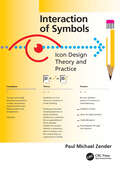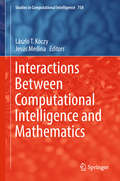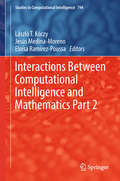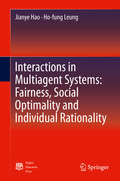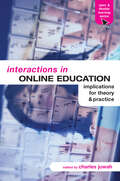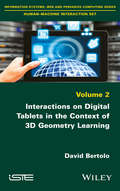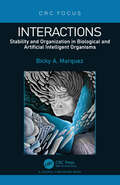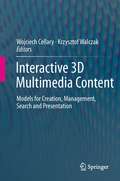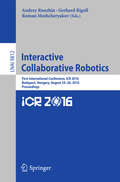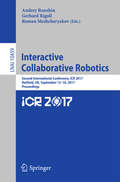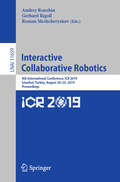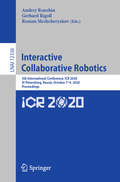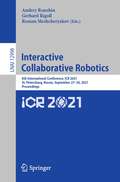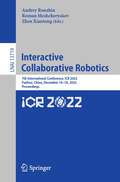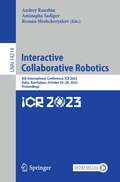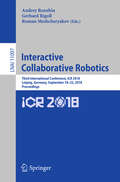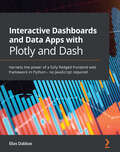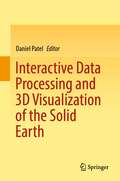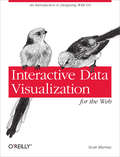- Table View
- List View
Interaction and Player Research in Game Development: 4th International Workshop, WIPlay 2025, Belo Horizonte, Brazil, September 8, 2025, Proceedings (Communications in Computer and Information Science #2623)
by Ticianne Darin Kamila Rios Georgia Cruz Leonardo Tórtoro Diego RiccaThis book constitutes the proceedings of the 4th International Workshop on Interaction and Player Research in Game Development, WIPlay 2025, which took place in Belo Horizonte, Brazil, in September 2025. The 10 full papers and 2 full papers included in this book were carefully reviewed and selected from 15 submissions. They were organized in topical sections as follows: Socially Conscious and inclusive game design; ethical game design and responsible gaming; and practical methods and frameworks for game design and evaluation.
Interaction for Designers: How To Make Things People Love
by Brian L.M BoylInteraction for Designers shows you how to connect a product with its users, whether it’s a simple toaster, a complex ecosystem of intelligent devices, or a single app on your smartphone. This book covers the entire design process so you can start with an idea and carry it through to an engaging final design. It carefully leads you step by step and richly illustrates each stage with examples drawn from business communication, social media and the social economy, consumer electronics, architecture and environments, health care, psychology, art and culture, education, athletics, automotive design, entertainment, fashion, the family home, and a wealth of others. You’ll learn how to brainstorm ideas, research them, explore them, evolve them into finished designs, pitch them, all with the goal of helping you make things that people love. Includes over 200 color images, a glossary, and links to web resources highlighting design concepts and designer interviews. http://interactionfordesigners.com/
Interaction of Symbols: Icon Design Theory and Practice
by Mike ZenderInteraction of Symbols is a book for everyone engaged with icon design. It presents a theory of how icons work: symbols in an icon interact to evoke meaning. From this theory flow design principles and practices based on evidence from Design and other disciplines such as Psychology, Perception, and Cognition. The theory, principles, and practices impact how all symbol-based communications are conceived, designed, and applied.The book focuses on icons that elicit a concept without any previous training or use of language. Findings from twenty years’ worth of empirical design research studies explore, illustrate, and support each principle, process, and recommendation. The book begins with a review of icon research from various fields before laying a conceptual foundation that grounds the theory of the book. After and elaborating on that theory are chapters that demonstrate how to Establish Contexts to Guide Comprehension, Glean Which Symbols to Draw, Learn How to Draw Understandable Symbols, Clarify Metaphor, and Use Icons to Decipher Icons in Icon Systems. Written and carefully designed for a broad audience, the book’s scholarly level is elevated while the presentation is approachable. Scholar or professional can skim, scan, or dig, it’s up to them.Heavily illustrated and supported with ample citations, it is not only a book for students and professionals within the field of communication design, but also for anyone who communicates with visual symbols, from healthcare professionals to software engineers, affecting all kinds of graphic communications from advertisements to assembly instructions.
Interactions Between Computational Intelligence and Mathematics (Studies in Computational Intelligence #758)
by László T. Kóczy Jesús MedinaThis book presents recent research in the field of interaction between computational intelligence and mathematics, ranging from theory to applications. Computational intelligence, or soft computing consists of various bio-inspired methods, especially fuzzy systems, artificial neural networks, evolutionary and memetic algorithms. These research areas were initiated by professionals in various applied fields, such as engineers, economists, and financial and medical experts. Although computational intelligence offered solutions (at least quasi-optimal solutions) for problems with high complexity, vague and undeterministic features, initially little attention was paid to the mathematical models and analysis of the methods successfully applied. A typical example is the extremely successful Mamdani-algorithm, and its modifications and extensions, applied since the mid-1970s, where the first analysis of the simplest cases, showing why this algorithm was so efficient and stable, was not given until the early 1990s.Since the mid-2000s, the authors have organized international conferences annually to focus on the mathematical methodological issues in connection with computational intelligence approaches. These conferences have attracted a large number of submissions with a wide scope of topics and quality. The editors selected several high-quality papers and approached the authors to submit an essentially extended and improved book chapter based on the lectures.This volume is the first contributed book on the subject.
Interactions Between Computational Intelligence and Mathematics Part 2
by László T. Kóczy Jesús Medina-Moreno Eloísa Ramírez-PoussaThis book presents recent research in the field of interaction between computational intelligence and mathematics. In the current technological age, we face the challenges of tackling very complex problems – in the usual sense, but also in the mathematical and theoretical computer science sense. However, even the most up-to-date results in mathematics, are unable to provide exact solutions of such problems, and no further technical advances will ever make it possible to find general and exact solutions. Constantly developing technologies (including social technologies) necessitate handling very complex problems. This has led to a search for acceptably “good” or precise solutions, which can be achieved by the combination of traditional mathematical techniques and computational intelligence tools, in order to solve the various problems emerging in many different areas to a satisfactory degree. Important funding programs, such as the European Commission’s current framework programme for research and innovation – Horizon 2020 – are devoted to the development of new instruments to deal with the current challenges. Without doubt, research topics associated with the interactions between computational intelligence and traditional mathematics play a key role. Presenting contributions from engineers, scientists and mathematicians, this book offers a series of novel solutions for meaningful and real-world problems that connect those research areas.
Interactions in Multiagent Systems: Fairness, Social Optimality and Individual Rationality
by Jianye Hao Ho-Fung LeungThisbook mainly aims at solving the problems in both cooperative and competitivemulti-agent systems (MASs), exploring aspects such as how agents caneffectively learn to achieve the shared optimal solution based on their localinformation and how they can learn to increase their individual utility byexploiting the weakness of their opponents. The book describes fundamental andadvanced techniques of how multi-agent systems can be engineered towards thegoal of ensuring fairness, social optimality, and individual rationality; awide range of further relevant topics are also covered both theoretically andexperimentally. The book will be beneficial to researchers in the fields ofmulti-agent systems, game theory and artificial intelligence in general, as wellas practitioners developing practical multi-agent systems.
Interactions in Online Education: Implications for Theory and Practice (Open and Flexible Learning Series)
by Charles JuwahInteractivity is at the very heart of learning and is evident at all levels of engagement, whether between fellow students, students and tutors, online learning materials or interfacing with the learning environment. Covering both theory and the practical implications of the issues discussed, this book provides international perspectives on key topics including: analysing and designing e-learning interactions, social and conceptual dimensions of learning, interactions in online discussions, interactions in peer learning and professional development of online facilitators. It is essential reading for all those involved in the design, implementation, management and use of open and flexible learning.
Interactions of Earth's Magnetotail Plasma with the Surface, Plasma, and Magnetic Anomalies of the Moon
by Yuki HaradaThis thesis describes the essential features of Moon-plasma interactions with a particular emphasis on the Earth's magnetotail plasma regime from both observational and theoretical standpoints. The Moon lacks a dense atmosphere as well as a strong intrinsic magnetic field. As a result, its interactions with the ambient plasma are drastically different from solar-wind interactions with magnetized planets such as Earth. The Moon encounters a wide range of plasma regime from the relatively dense, cold, supersonic solar-wind plasma to the low-density, hot, subsonic plasma in the geomagnetic tail. In this book, the author presents a series of new observations from recent lunar missions (i. e. , Kaguya, ARTEMIS, and Chandrayaan-1), demonstrating the importance of the electron gyro-scale dynamics, plasma of lunar origin, and hot plasma interactions with lunar magnetic anomalies. The similarity and difference between the Moon-plasma interactions in the geomagnetic tail and those in the solar wind are discussed throughout the thesis. The basic knowledge presented in this book can be applied to plasma interactions with airless bodies throughout the solar system and beyond.
Interactions on Digital Tablets in the Context of 3D Geometry Learning: Contributions and Assessments
by David BertoloOver the last few years, multi-touch mobile devices have become increasingly common. However, very few applications in the context of 3D geometry learning can be found in app stores. Manipulating a 3D scene with a 2D device is the main difficulty of such applications. Throughout this book, the author focuses on allowing young students to manipulate, observe and modify 3D scenes using new technologies brought about by digital tablets. Through a user-centered approach, the author proposes a grammar of interactions adapted to young learners, and then evaluates acceptability, ease of use and ease of learning of the interactions proposed. Finally, the author studies in situ the pedagogic benefits of the use of tablets with an app based on the suggested grammar. The results show that students are able to manipulate, observe and modify 3D scenes using an adapted set of interactions. Moreover, in the context of 3D geometry learning, a significant contribution has been observed in two classes when students use such an application. The approach here focuses on interactions with digital tablets to increase learning rather than on technology. First, defining which interactions allow pupils to realize tasks needed in the learning process, then, evaluating the impact of these interactions on the learning process. This is the first time that both interactions and the learning process have been taken into account at the same time.
Interactions with Search Systems
by Ryen W. WhiteInformation seeking is a fundamental human activity. In the modern world, it is frequently conducted through interactions with search systems. The retrieval and comprehension of information returned by these systems is a key part of decision making and action in a broad range of settings. Advances in data availability coupled with new interaction paradigms, and mobile and cloud computing capabilities, have created a broad range of new opportunities for information access and use. In this comprehensive book for professionals, researchers, and students involved in search system design and evaluation, search expert Ryen White discusses how search systems can capitalize on new capabilities and how next-generation systems must support higher order search activities such as task completion, learning, and decision making. He outlines the implications of these changes for the evolution of search evaluation, as well as challenges that extend beyond search systems in areas such as privacy and societal benefit.
Interactions: Stability and Organization in Biological and Artificial Intelligent Organisms
by Bicky A. MarquezThis book examines how predicting the future based on analytical and empirical models is essential for our species' survival, stable organization, and well-being. At a high level, information exchange, mainly through communication between people, fosters a deeper understanding of reality and strengthens human bonds, ultimately contributing to the emergence of societies as new creatures or "superorganisms" with significantly more data to feed those models. Communication is fundamental to the development of complex organisms, the maintenance of internal order, and the propagation of knowledge via cultural packets. The human brain's plasticity, memory, and learning capabilities enable storage and rapid responses to new information, enhancing our decision-making and forecasting abilities. The book discusses the complexity of multicellular organisms and the mechanisms that coordinate their internal subsystems, highlighting the emergence of hierarchies from fundamental particles to networks of superorganisms. The interconnectedness of biological oscillators with prominent similarities enables synchronization as a foundation for their superior organization and collective agreements. Finally, this book explores the human quest to enhance survival through accumulating knowledge and developing tools and technologies. It underscores the significance of artificial intelligence as a tool to support cognitive abilities and address global challenges while acknowledging our limited control over reality within an independently operating universe.
Interactive 3D Multimedia Content
by Krzysztof Walczak Wojciech CellaryThe book describes recent research results in the areas of modelling, creation, management and presentation of interactive 3D multimedia content. The book describes the current state of the art in the field and identifies the most important research and design issues. Consecutive chapters address these issues. These are: database modelling of 3D content, security in 3D environments, describing interactivity of content, searching content, visualization of search results, modelling mixed reality content, and efficient creation of interactive 3D content. Each chapter is illustrated with example applications based on the proposed approach. The final chapter discusses some important ethical issues related to the widespread use of virtual environments in everyday life. The book provides ready to use solutions for many important problems related to the creation of interactive 3D multimedia applications and will be a primary reading for researchers and developers working in this domain.
Interactive Applications Using Matplotlib
by Benjamin V. RootThis book is intended for Python programmers who want to do more than just see their data. Experience with GUI toolkits is not required, so this book can be an excellent complement to other GUI programming resources.
Interactive Collaborative Robotics
by Andrey Ronzhin Gerhard Rigoll Roman MeshcheryakovThis book constitutes the proceedings of the First International Conference on Interactive Collaborative Robotics, ICR 2016, held in Budapest, Hungary, in August 2016. The 29 papers presented in this volume were carefully reviewed and selected from 48 submissions.
Interactive Collaborative Robotics
by Andrey Ronzhin Gerhard Rigoll Roman MeshcheryakovThis book constitutes the proceedings of the Second International Conference on Interactive Collaborative Robotics, ICR 2017, held in Hatfield, UK, in September 2017, as a satellite event of the 19th International Conference on Speech and Computer, SPECOM 2017. The 30 papers presented in this volume were carefully reviewed and selected from 51 submissions. This new conference invites researchers in the area of social robotics and collaborative robotics to share experience in human-machine interaction research and development of robotic and cyberphysical systems. Topics addressed are: assistive robots, child-robot interaction, collaborative robotics, educational robotics, human-robot interaction, medical robotics, robotic mobility systems, robots at home, robot control and communication, social robotics, as well as safety robot behavior.
Interactive Collaborative Robotics: 4th International Conference, ICR 2019, Istanbul, Turkey, August 20–25, 2019, Proceedings (Lecture Notes in Computer Science #11659)
by Andrey Ronzhin Gerhard Rigoll Roman MeshcheryakovThis book constitutes the refereed proceedings of the 4th International Conference on Interactive Collaborative Robotics, ICR 2019, held in Istanbul, Turkey, in August 2019. The 32 papers presented in this volume were carefully reviewed and selected from 46 submissions. They deal with challenges of human-robot interaction; robot control and behavior in social robotics and collaborative robotics; and applied robotic and cyber-physical systems.
Interactive Collaborative Robotics: 5th International Conference, ICR 2020, St Petersburg, Russia, October 7-9, 2020, Proceedings (Lecture Notes in Computer Science #12336)
by Andrey Ronzhin Gerhard Rigoll Roman MeshcheryakovThis book constitutes the proceedings of the 5th International Conference on Interactive Collaborative Robotics, ICR 2020, held in St. Petersburg, Russia, in October 2020. The 31 papers presented were carefully reviewed and selected from 62 submissions. Challenges of human-robot interaction, robot control and behavior in social robotics and collaborative robotics, as well as applied robotic and cyber-physical systems are mainly discussed in the papers.
Interactive Collaborative Robotics: 6th International Conference, ICR 2021, St. Petersburg, Russia, September 27–30, 2021, Proceedings (Lecture Notes in Computer Science #12998)
by Andrey Ronzhin Gerhard Rigoll Roman MeshcheryakovThis book constitutes the proceedings of the 6th International Conference on Interactive Collaborative Robotics, ICR 2021, held in St. Petersburg, Russia, in October 2021. The 19 papers presented were carefully reviewed and selected from 40 submissions. Challenges of human-robot interaction, robot control and behavior in social robotics and collaborative robotics, as well as applied robotic and cyber-physical systems are mainly discussed in the papers.
Interactive Collaborative Robotics: 7th International Conference, ICR 2022, Fuzhou, China, December 16-18, 2022, Proceedings (Lecture Notes in Computer Science #13719)
by Andrey Ronzhin Roman Meshcheryakov Zhen XiantongThis book constitutes the proceedings of the 7th International Conference on Interactive Collaborative Robotics, ICR 2022, held in Fuzhou, China, in December 2022. The 25 papers presented were carefully reviewed and selected from 45 submissions. Challenges of human-robot interaction, robot control and behavior in social robotics and collaborative robotics, as well as applied robotic and cyber-physical systems are mainly discussed in the papers.
Interactive Collaborative Robotics: 8th International Conference, ICR 2023, Baku, Azerbaijan, October 25–29, 2023, Proceedings (Lecture Notes in Computer Science #14214)
by Andrey Ronzhin Roman Meshcheryakov Aminagha SadigovThis book constitutes the refereed proceedings of the 8th International Conference on Interactive Collaborative Robotics, ICR 2023, held in Baku, Azerbaijan, during October 25–29, 2023.The 33 full papers included in this book were carefully reviewed and selected from 56 submissions. They were organized in topical sections as follows: focused the foundations and means of collaborative behavior of one or more robots physically interacting with hu-mans in operational environments configured with embedded sensor networks and cloud services under uncertainty and environmental variability.
Interactive Collaborative Robotics: 9th International Conference, ICR 2024, Mexico City, Mexico, October 14–18, 2024, Proceedings (Lecture Notes in Computer Science #14898)
by Andrey Ronzhin Roman Meshcheryakov Jesus SavageThis book constitutes the refereed proceedings of the 9th International Conference on Interactive Collaborative Robotics, ICR 2024, held in Mexico City, Mexico, during October 14–18, 2024. The 32 full papers presented here were carefully reviewed and selected from 62 submissions. These papers focus on the challenges, trends and applications of Human-Robot collaboration in various domains such as Industry, Healthcare, Society and Education.
Interactive Collaborative Robotics: Third International Conference, ICR 2018, Leipzig, Germany, September 18–22, 2018, Proceedings (Lecture Notes in Computer Science #11097)
by Andrey Ronzhin Gerhard Rigoll Roman MeshcheryakovThis book constitutes the proceedings of the Third International Conference on Interactive Collaborative Robotics, ICR 2018, held in Leipzig, Germany, in September 2018, as a satellite event of the 20th International Conference on Speech and Computer, SPECOM 2018.The 30 papers presented in this volume were carefully reviewed and selected from 51 submissions. The papers presents challenges of human-robot interaction, robot control and behavior in social robotics and collaborative robotics, as well as applied robotic and cyberphysical systems.
Interactive Dashboards and Data Apps with Plotly and Dash: Harness the power of a fully fledged frontend web framework in Python – no JavaScript required
by Elias DabbasBuild web-based, mobile-friendly analytic apps and interactive dashboards with PythonKey FeaturesDevelop data apps and dashboards without any knowledge of JavaScriptMap different types of data such as integers, floats, and dates to bar charts, scatter plots, and moreCreate controls and visual elements with multiple inputs and outputs and add functionality to the app as per your requirementsBook DescriptionPlotly's Dash framework is a life-saver for Python developers who want to develop complete data apps and interactive dashboards without JavaScript, but you'll need to have the right guide to make sure you're getting the most of it. With the help of this book, you'll be able to explore the functionalities of Dash for visualizing data in different ways.Interactive Dashboards and Data Apps with Plotly and Dash will first give you an overview of the Dash ecosystem, its main packages, and the third-party packages crucial for structuring and building different parts of your apps. You'll learn how to create a basic Dash app and add different features to it.Next, you'll integrate controls such as dropdowns, checkboxes, sliders, date pickers, and more in the app and then link them to charts and other outputs. Depending on the data you are visualizing, you'll also add several types of charts, including scatter plots, line plots, bar charts, histograms, and maps, as well as explore the options available for customizing them.By the end of this book, you'll have developed the skills you need to create and deploy an interactive dashboard, handle complexities and code refactoring, and understand the process of improving your application.What you will learnFind out how to run a fully interactive and easy-to-use appConvert your charts to various formats including images and HTML filesUse Plotly Express and the grammar of graphics for easily mapping data to various visual attributesCreate different chart types, such as bar charts, scatter plots, histograms, maps, and moreExpand your app by creating dynamic pages that generate content based on URLsImplement new callbacks to manage charts based on URLs and vice versaWho this book is forThis Plotly Dash book is for data professionals and data analysts who want to gain a better understanding of their data with the help of different visualizations and dashboards – and without having to use JS. Basic knowledge of the Python programming language and HTML will help you to grasp the concepts covered in this book more effectively, but it's not a prerequisite.
Interactive Data Processing and 3D Visualization of the Solid Earth
by Daniel PatelThis book presents works detailing the application of processing and visualization techniques for analyzing the Earth’s subsurface. The topic of the book is interactive data processing and interactive 3D visualization techniques used on subsurface data. Interactive processing of data together with interactive visualization is a powerful combination which has in the recent years become possible due to hardware and algorithm advances in. The combination enables the user to perform interactive exploration and filtering of datasets while simultaneously visualizing the results so that insights can be made immediately. This makes it possible to quickly form hypotheses and draw conclusions. Case studies from the geosciences are not as often presented in the scientific visualization and computer graphics community as e.g., studies on medical, biological or chemical data. This book will give researchers in the field of visualization and computer graphics valuable insight into the open visualization challenges in the geosciences, and how certain problems are currently solved using domain specific processing and visualization techniques. Conversely, readers from the geosciences will gain valuable insight into relevant visualization and interactive processing techniques. Subsurface data has interesting characteristics such as its solid nature, large range of scales and high degree of uncertainty, which makes it challenging to visualize with standard methods. It is also noteworthy that parallel fields of research have taken place in geosciences and in computer graphics, with different terminology when it comes to representing geometry, describing terrains, interpolating data and (example-based) synthesis of data. The domains covered in this book are geology, digital terrains, seismic data, reservoir visualization and CO2 storage. The technologies covered are 3D visualization, visualization of large datasets, 3D modelling, machine learning, virtual reality, seismic interpretation and multidisciplinary collaboration. People within any of these domains and technologies are potential readers of the book.
Interactive Data Visualization for the Web
by Scott MurrayCreate and publish your own interactive data visualization projects on the Web--even if you have little or no experience with data visualization or web development. It's easy and fun with this practical, hands-on introduction. Author Scott Murray teaches you the fundamental concepts and methods of D3, a JavaScript library that lets you express data visually in a web browser. Along the way, you'll expand your web programming skills, using tools such as HTML and JavaScript. This step-by-step guide is ideal whether you're a designer or visual artist with no programming experience, a reporter exploring the new frontier of data journalism, or anyone who wants to visualize and share data. Learn HTML, CSS, JavaScript, and SVG basics Dynamically generate web page elements from your data--and choose visual encoding rules to style them Create bar charts, scatter plots, pie charts, stacked bar charts, and force-directed layouts Use smooth, animated transitions to show changes in your data Introduce interactivity to help users explore data through different views Create customized geographic maps with data Explore hands-on with downloadable code and over 100 examples


